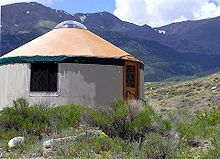Enthusiasts in other countries have taken the visual idea of the yurta round, semi-permanent tentand have adapted it to their cultural needs. Although those structures may be copied to some extent from the originals found in Central Asia, they often have some different features in their design that adapt them to different climate and use.
In the United States and Canada, yurts are made using hi-tech materials. They are highly engineered and built for extreme weather conditions. In addition, erecting one can take days and they are not intended to be moved often. These North American yurts are better named yurt derivations, as they are no longer round felt homes that are easy to mount, dismount and transport. North American yurts and yurt derivations were pioneered by William Coperthwaite in the 1960s, after he was inspired to build them by an article about Supreme Court Justice William O. Douglas' visit to Mongolia.<1>
In 1978, Oregon-based company Pacific Yurts became the first to manufacture yurts using architectural fabrics and structural engineering, paving the way for yurts to become popular attractions at ski resorts and campgrounds. In 1993, Oregon became the first state to incorporate yurts into its Parks Department as year round camping facilities. Since then, at least 17 other US States have introduced yurt camping into their own parks departments.<2>
In Europe, a closer approximation to the Mongolian and Central Asian yurt is in production in several countries. These tents use local hardwood, and often are adapted for a wetter climate with steeper roof profiles and waterproof canvas. In essence they are yurts, but some lack the felt cover that is present in traditional yurt.
Different groups and individuals use yurts for a variety of purposes, from full-time housing to school rooms. In some provincial parks in Canada, and state parks in several US states, permanent yurts are available for camping.

A yurt-derived structure in the Colorado mountains
more at link:
http://en.wikipedia.org/wiki/Yurt